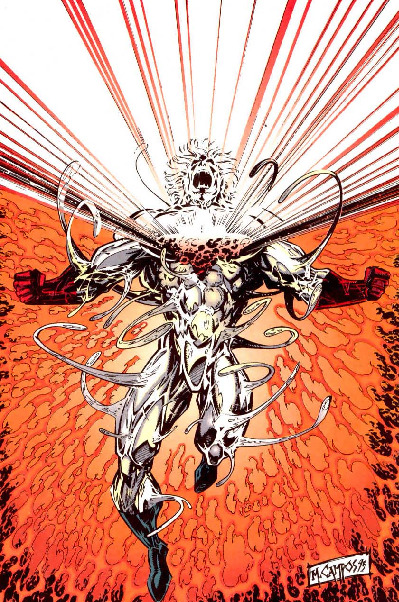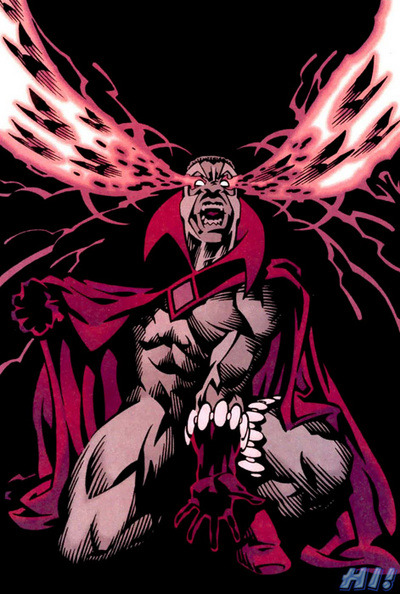writer: Grant Morrison
artist: Frazer Irving| via Previews World |
Ray Spass, the dying screenwriter who has just met the lead character from his latest script, has been thrust into the story of his life. Max Nomax is a lunatic creation who claims he's real and that his story was downloaded into Ray's brain. Except now Ray explains how he came up with Max in the first place, inspired by a series of previous efforts on a character who's become copyright-free.
And now the movie Annihilator could very well become is beginning to emerge. Here are a bunch of quotes from the issue that could easily comprise the dialogue in the trailer:
"This man's creativity demands a ferocious, unpredictable expression."
"It's the story of a rebel artist wrongfully imprisoned in a haunted lunatic asylum. In space. What the hell does it look like?"
"You're a fallen specimen, Ray, weak and self-indulgent. This so-called screenplay of yours is the work of a contemptuous, self-loathing creator."
"I'm dying -- I just woke up thinking it was all a dream and then I remembered -- I'm actually dying."
"I pitched them the whole idea in space. 'The Shining meets Alien.'"
"This world. This mortal sewer."
"Send me to the abyss. I'll show you the source of all art."
Cast Brad Pitt as Ray Spass, have Terry Gilliam direct, the long-awaited reunion after Twelve Monkeys.
What's more, especially with those first three quotes, I can't help but begin to view Annihilator as Morrison grappling with his creative legacy. His admirers think Morrison is a genius and he remains one of the most respected creators in comic books, but he's never attained the same wider respect as Alan Moore or Neil Gaiman, as if his entire life's work has already been refuted. Time and again I've attempted to do my part in explaining just what he's done, but I can imagine that it must be frustrating to think all his efforts have been in vain, all the praise he's received being, in the end, hollow. For so long, Morrison has dedicated himself to the vital expression of superheroes, and yet this has proved impossible to distinguish or contend with what Moore achieved with Watchmen, a work that transcended the form because of its ironic detachment. Morrison believes in big ideas and has consistently chased after them in his work, but he's long sought an anchor that makes his ambition accessible to wide audiences, not just visible but vital.
After the release of Christopher Nolan's Interstellar, I think something like Annihilator might have room to exist in greater context. Nolan's career has had the benefit of wide appreciation following his superhero work with the Dark Knight trilogy (somewhat ironic, there), and to some (such as myself) his latest film is a clear culmination of his prior films. Annihilator is very much like that for Grant Morrison. Yet it's being released by a relatively anonymous publisher, which may make it all the more important that it receive the treatment Morrison may have intended for it, adaptation into a major motion picture, something Moore and Gaiman have received on numerous occasions but which has still eluded him. I'm becoming more and more convinced that Annihilator is exactly the project he's been waiting to deliver for the honor. At first I wondered if it could stand out or even sound plausible as a blockbuster. The longer the story continues, the more I'm convinced. He knows exactly what he's doing.
We'll see.
What's more, especially with those first three quotes, I can't help but begin to view Annihilator as Morrison grappling with his creative legacy. His admirers think Morrison is a genius and he remains one of the most respected creators in comic books, but he's never attained the same wider respect as Alan Moore or Neil Gaiman, as if his entire life's work has already been refuted. Time and again I've attempted to do my part in explaining just what he's done, but I can imagine that it must be frustrating to think all his efforts have been in vain, all the praise he's received being, in the end, hollow. For so long, Morrison has dedicated himself to the vital expression of superheroes, and yet this has proved impossible to distinguish or contend with what Moore achieved with Watchmen, a work that transcended the form because of its ironic detachment. Morrison believes in big ideas and has consistently chased after them in his work, but he's long sought an anchor that makes his ambition accessible to wide audiences, not just visible but vital.
After the release of Christopher Nolan's Interstellar, I think something like Annihilator might have room to exist in greater context. Nolan's career has had the benefit of wide appreciation following his superhero work with the Dark Knight trilogy (somewhat ironic, there), and to some (such as myself) his latest film is a clear culmination of his prior films. Annihilator is very much like that for Grant Morrison. Yet it's being released by a relatively anonymous publisher, which may make it all the more important that it receive the treatment Morrison may have intended for it, adaptation into a major motion picture, something Moore and Gaiman have received on numerous occasions but which has still eluded him. I'm becoming more and more convinced that Annihilator is exactly the project he's been waiting to deliver for the honor. At first I wondered if it could stand out or even sound plausible as a blockbuster. The longer the story continues, the more I'm convinced. He knows exactly what he's doing.
We'll see.









